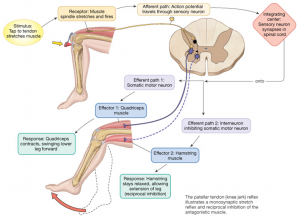Reciprocal Inhibition
Most muscles in the body act in pairs, working together to make moving and doing possible.
When one muscle contracts or shortens, the opposing muscle relaxes or lengthens.
This is the concept known as reciprocal inhibition.
Make a muscle with your bicep while sitting at your desk and touch that bicep with the other hand.
You should feel that it has hardened or engaged slightly.
Touch the tricep, its opposite muscle, and it will be relaxed.
Now pick up something on your desk and you should feel the same thing magnified. The bicep probably gets a little harder and the triceps relaxes more.
This deep primal reflex is essential to human movement and is limited, sometimes severely by muscle imbalances in the body.
Let’s say that my hamstrings (the muscle at the back of the thigh) are tight and my quadriceps (the muscle at the front of the thigh), for the sake of this discussion, are weak.
From a standing position, I lift my knee off of the ground and attempt to extend my leg straight.
This action requires a shortening of the quadriceps and an extension of the hamstring. But if the quadriceps lacks the tone to shorten there will be no corresponding call for the hamstring to lengthen.
Muscle pulls and cramps are also the result of a “misfiring” of reciprocal inhibition.
Two muscles simultaneously contract at the same time rather than with the natural give and take of flexion and extension, and the stronger muscle usually dominates resulting in a cramp or injury to the weaker muscle.
Reciprocal inhibition is a deep reflex that you can’t control but you can work your body into a vessel that allows for the machine to work more closely to its design.

